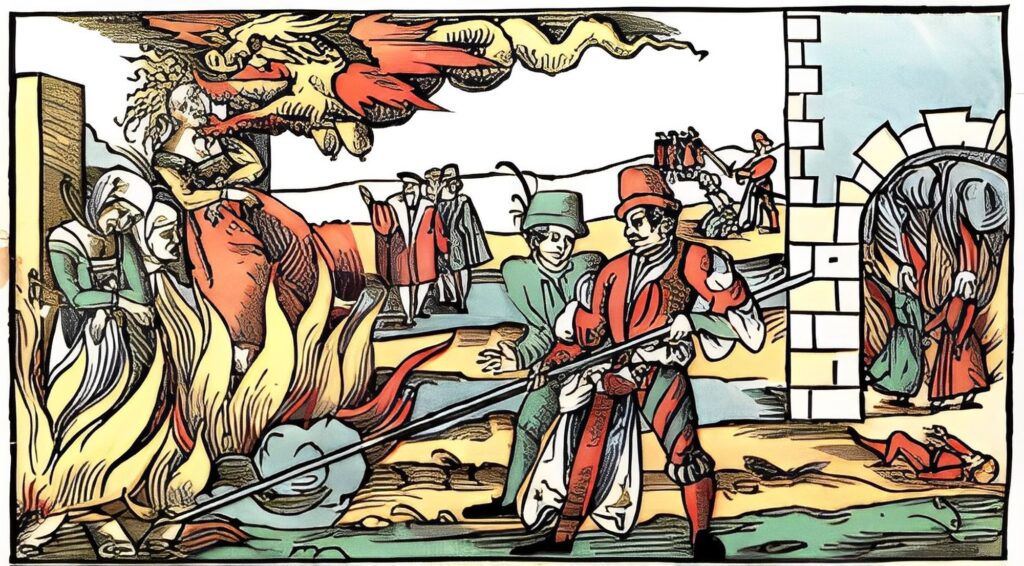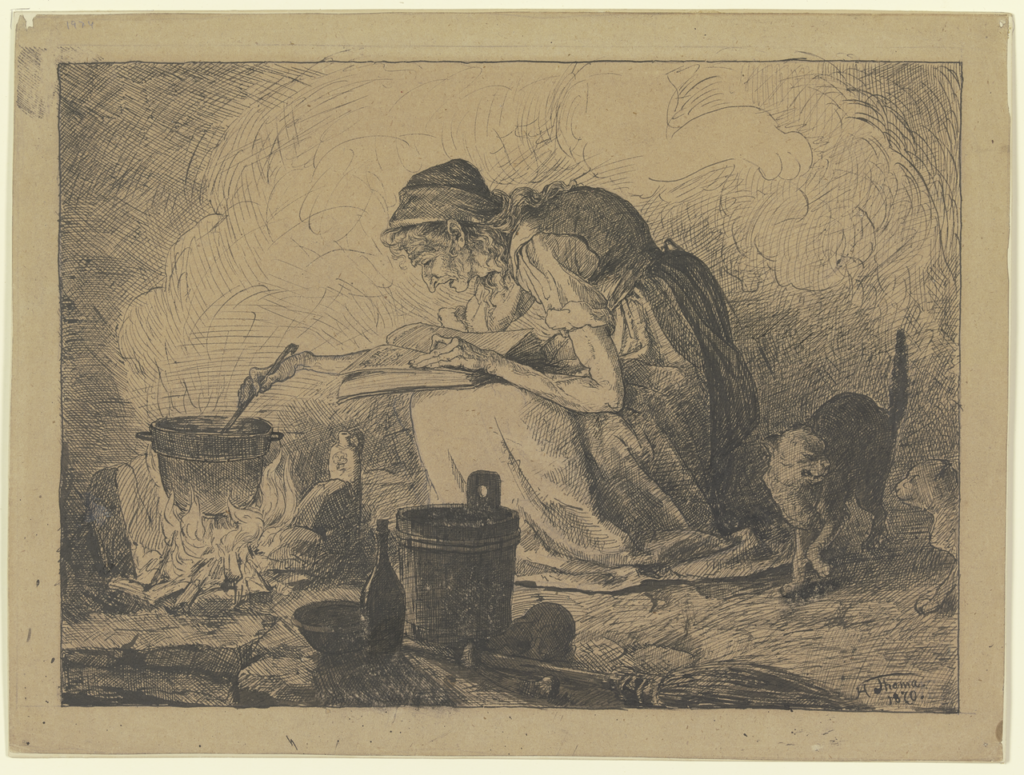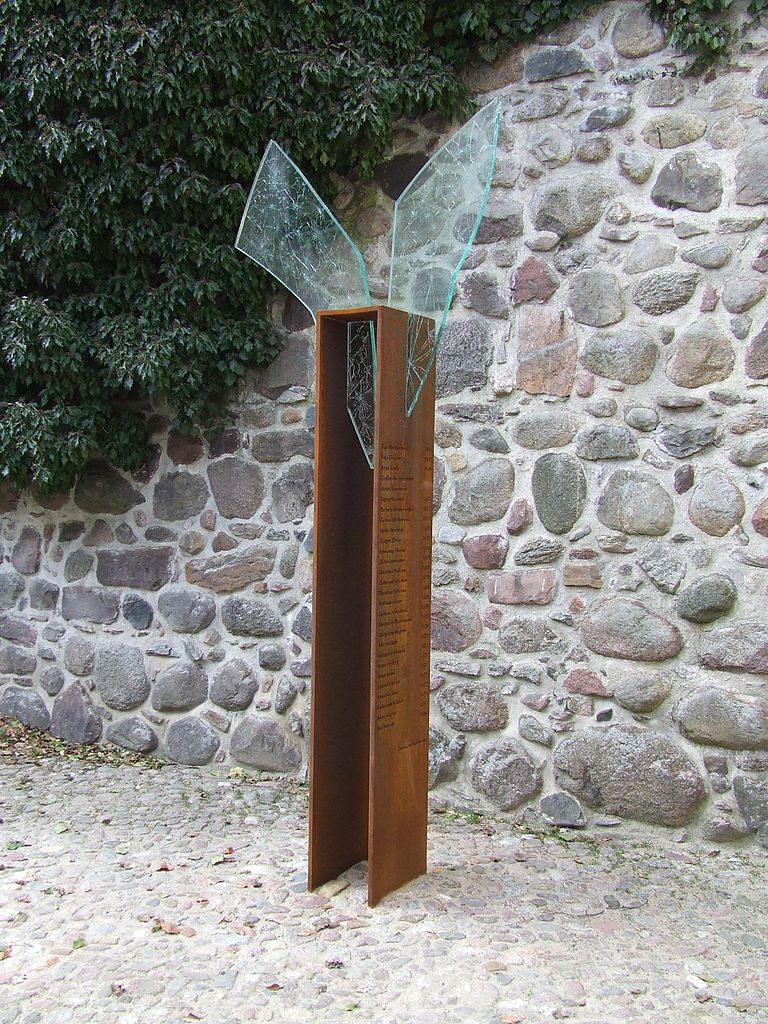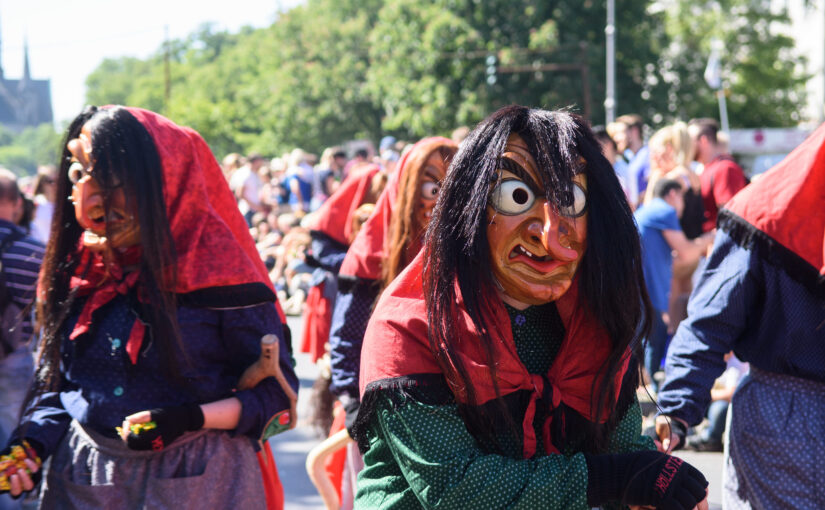Belief in witchcraft is ancient. The Germanic tribes already knew sorceresses, and to them, magic was an undeniable part of reality. During the Easter expansion into the Mark Brandenburg in the 12th and 13th centuries, the idea that witches had turned their backs on God and made a pact with the devil gradually spread throughout the German-speaking world.
Witches were thought to harness dark powers with the aid of the horned one, using black magic for harmful purposes. Envy, resentment, and jealousy often fueled accusations of witchcraft, as did unexplained natural events and epidemics. Witches were believed to possess the ability to harm people and animals through weather spells and the ‹evil eye.›
In the Middle Ages and early modern period, diseases, plagues, and sudden deaths defied explanation, as did strange natural occurrences. When cows stopped giving milk or crops failed, suspicion often fell on witches, believed to have cast spells on the livestock or the harvest.
In 1484, Pope Innocent VIII had issued the the notorious «Witches Bull» (Bull Summis desiderantes)—at the urging of the Dominican and inquisitor Heinrich Kramer (ca. 1430-1505), who wrote a commentary on it in 1487, which was given the title «Malleus Maleficarum» (The Hammer of Witches).
This work became a widely circulated guide for witch judges, thanks in part to the newly invented printing press. The Malleus Maleficarum was the first ‹practical handbook› on witch-hunting, blending both theory and practice. It provided detailed instructions for investigating, interrogating, and convicting those accused of witchcraft.
Witch trials often began on the fringes of society, with marginalized individuals as the primary targets—particularly women. These women, often unmarried, lacked the legal and social protection that a husband might provide.
Because women were considered the weaker sex and assumed to be more vulnerable to temptation and sin, myths and writings like the Malleus Maleficarum fueled the widespread belief that they were more likely to give themselves over to evil. The growing independence of women was seen as a sign of devilish influence, and it was believed that women gained their supposed powers through sexual intercourse with the Devil.

Torture played a central role in these trials, intended to extract (false) confessions and force the accused to name other supposed witches. This led to a vicious cycle of accusations, with one alleged witch denouncing others, triggering local witch hunts and mass executions.
By the 17th century, Malleus Maleficarum had been published in dozens of editions, its influence shaping witch trials across Europe. Even in Protestant regions like Kurbrandenburg, both women and men were accused of «courting the devil» and sentenced to death by fire after enduring brutal, torturous trials.
Though a critic of the Catholic Church, Martin Luther was a staunch supporter of the persecution of witches and fervently backed the anti-witch movement. In his sermons on witchcraft, Luther called for the persecution and execution of those accused, citing the Old Testament precept: «Thou shalt not suffer a witch to live» (Exodus 22:17).
Many confessions during these trials were coerced through horrific methods of torture, leaving behind records filled with false admissions.
According to Chapter XIII of Book II of the Sachsenspiegel, the most influential legal code of the Middle Ages, any Christian man convicted of sorcery or poisoning was to be burned at the stake: «Any Christian man who disbelieves or practices sorcery, or is convicted of poisoning, shall be burned at the stake.»
The pyres were built with several cubic meters of fuel, and the executions were often gruesome. Those condemned didn’t always die immediately from the flames. If the court showed «mercy,» the executioner would strangle the accused shortly before the fire was lit—a grim act of compassion. The burning was intended to purge the body of the demon believed to be inhabiting it, sending the evil spirit up in smoke for good.
In the first Berlin city register, which covers up to 1448, nineteen cases were recorded in which individuals were sentenced to death by burning at the stake. Among these, two elderly women were executed for alleged sorcery.
The first recorded case of sorcery in Berlin dates back to 1390. Wolborg, an elderly woman, gave two berries to Else Schneider. After eating them, Else fell seriously ill and turned to Wolborg for help. In front of a small crowd, Wolborg admitted that she had caused Else’s illness and claimed that only she could cure it.
Wolborg demanded money for the cure, but despite her efforts, Else’s condition worsened. This led to an indictment, and the court found Wolborg guilty of sorcery. She was sentenced to death by fire. The records offer no further details about Wolborg’s case, leaving much to speculation.
The second case, from 1423, is even more vague. The name of the accused woman is not even recorded in the Berlin city register. It is only noted that she was accused of practicing sorcery, mixing powder, and preparing magical concoctions in the dead of night. Like Wolborg, she was condemned by the court and burned at the stake. Unfortunately, little else is known about this second case, and the woman’s identity remains a mystery.
Berlin saw a resurgence of witch trials in the mid-16th century, driven by a volatile mix of superstition, religious conflicts, epidemics, and the harsh effects of the Little Ice Age on crops and livestock. These hardships fueled a search for scapegoats, ushering in a new era of cruelty across Europe.
The Reformation, ignited by Martin Luther’s 95 Theses in 1517, had already destabilized the old religious order. In 1535, Joachim II, Elector of Brandenburg, converted to Protestantism, further fracturing the religious landscape.
A prolonged period of harsh climate and failed harvests had decimated the population over generations, while plague outbreaks repeatedly ravaged Europe, including Brandenburg. Amid these crises, many sought someone to blame, and witches—along with Jews—became convenient scapegoats.
In 1510, in Berlin, 39 Jews were burned alive following the notorious «host desecration trial.» Two others, having been baptized, were spared and executed by the sword instead.
At the same time, the so-called «storm witches» were believed to have caused widespread damage to crops and buildings. According to legend, two women were accused of using weather magic to ruin the harvest of grain and wine, casting spells to bring devastation upon the land.
According to legend, an innkeeper who had sheltered two women accused of witchcraft thwarted their damage spell by pouring enchanted water over them, causing the witches to turn to ice.
While the story may be apocryphal, it is true that a violent storm struck Berlin in the mid-16th century, causing significant damage. A surviving document dated June 15, 1551, reports the repair of the bell tower of the Nikolaikirche, confirming that a fierce thunderstorm had indeed damaged the spire, tower, and walls.
In 1699, Ferdinand Pusthius chronicled an execution that followed shortly thereafter: «In 1552, a sorceress was burned to death in Berlin. As the fire was ignited, a heron flew in and stayed for as long as one could recite the Lord’s Prayer, then flew away carrying a piece of her fur. Several hundred people witnessed this and believed it to be the Devil himself.»
The following year, two more women were burned at the stake in Berlin. Under torture, they confessed to the horrific crime of dismembering and cooking a child. Their alleged goal was to create a magical substance from the body to drive up prices, particularly for food.

The most violent period of witch hunts in Germany occurred between 1620 and 1635—though not in Berlin. Elector Joachim II had already expelled the particularly zealous Dominican friars from the city decades earlier. He converted their monastery, located next to the palace, into a Protestant court church, effectively curbing their influence.
However, the small town of Bernau, located just north of Berlin in the Mark Brandenburg, was not spared. Here, a notorious witch hunt erupted.
According to legend, at the dawn of the 17th century, an elector rode into Bernau, and as he passed through the town gate, his horses suddenly collapsed. The animals, it is believed, had either been driven to exhaustion beforehand or had become so overheated that the cold of the town gate caused their circulation to fail.
When the horses died on the spot, the coachman claimed that witches had caused their demise. Linking the tragic event to witchcraft, the town council acted swiftly, arresting several women on suspicion of sorcery.
The Tobias-Seiler Chronicle of 1736 records at least 22 such cases, where townspeople were condemned to death for allegedly making pacts with the «Lord of Darkness.» These women and men were burned alive, often to the cheers and jeers of the crowd.
It didn’t take much to be accused of witchcraft in those days.
Jürgen Crone and his wife, Emerentia, were arrested after another accused woman provided information against them. The couple came from a small village, where Jürgen worked as a trained baker, and Emerentia occasionally assisted him. However, work was scarce in their village, so they decided to move to Bernau in search of better opportunities.
They opened a modest bakery, and their bread quickly gained local fame for its unique flavor—infused with hints of lemon and bitter orange. Luck seemed to be on their side, the bakery developed magnificently, and before long, Emerentia became pregnant.
But their good fortune raised suspicions. A neighbor, envious of the couple’s rapid success, accused them of witchcraft. The neighbor’s claim was that the bread and rolls they made, «of the most exquisite taste,» could only be the work of the devil.
Jürgen Crone was promptly sent to the torture cellar, where he died on April 24, 1618. His body was then burned at the stake.
Emerentia, still carrying their child, was allowed to give birth before being subjected to the same fate. Just three months after her husband’s death, she too was tortured, then burned alive as a supposed witch.
Denunciation and envy blatantly fueled the persecution of witches back then. And this was not only the case with Emerentia and Jürgen. Another well-known example of the Bernau witch hunt is that of the Meermann family.
Dorothea Meermann, known as ‹Orthie,› was a widow who lived with the weight of suspicion hanging over her for much of her life. Both her mother and grandmother had been executed for witchcraft, and in those times, any family history of witchcraft was seen as evidence that the «art of sorcery» had been passed down through the generations. It was widely believed that once the devil had entered a family, he could easily find his way into subsequent members.
In 1617, Orthie was publicly accused of witchcraft by Gertrud Mühlenbeck, another woman who herself was under suspicion. Under torture, Gertrud named many others as witches, setting off a chain of accusations that swept through the town.
The charges against Orthie ranged from the absurd to the fantastical. Conrad Tiechel, a journeyman nail smith, claimed that a «ghoulish black monster» had been seen sitting on the roof of her house, She was feeding the dragon. He alleged that the dragon entered and exited her home, and that she had locked herself inside for days when another woman, Mrs. Grunow, was imprisoned. Neighbors, too, contributed bizarre accusations—one woman swore that Orthie had given her an egg cake filled with hair and blood, while a neighbor, Matthes Kröchel, complained that his corn had gone moldy after contact with her.
Thomas Belling, the town clerk, reminded the court that Orthie’s mother and grandmother had also been convicted of sorcery and executed. This familial history provided the council with all the «evidence» it needed to order her torture.
Her son-in-law Hans Becker was her defense lawyer in court and wrote a letter to the Elector in May 1619 to bring the trial to an end. The letter made it clear that they could bear no further costs and would bow to the judgment. Now the council, for its part, also wrote to the sovereign. The Elector did not make a decision, but referred the case to the Faculty of Law in Frankfurt for further review.
The council, undeterred, continued with the case. But despite the pressure of torture, Orthie did not confess to any of the charges against her. Which was very unusual. Most accused people quickly gave in under the threat of pain and suffering.
A confession from the accused was necessary for a death sentence. That is why it was decided to continue the torture. Dorothea Meermann’s breasts were pulled with red-hot tongs. The trial dragged on for two years until Dorothea Meermann died under torture.
On the morning of August 18, 1619, a guard brought Dorothea outside on his back so that she could relieve herself. When the guard tried to bring her back inside, her body lay lifeless on the ground. The council and the executioner inspected the body. They recorded that her neck was broken.
Seiler writes in his chronicle: «Now that the torture of this Orthie Meermann was once again carried out in the most severe manner, it happened that she died unexpectedly in the custodie (custody).» Her body was buried in unconsecrated ground at the high court.
Catarina Selchow, the daughter of Dorothea Meermann, was herself suspected of witchcraft when she approached the executioner who had tortured her mother. She was sentenced to death by burning in 1621. Among other things, she was accused of having sent the evil spirit to her mother in prison, which would have put her to sleep and taken away her pain. Catarina Selchow was burned to death on June 1, 1621.
According to Seiler’s chronicle, the last witch trial in Bernau took place in 1658. Today, the names of Dorothea Meermann and her executed family members are inscribed on a memorial next to the Bernau executioner’s house. It commemorates the 25 women and three men who were persecuted, tortured and executed for alleged sorcery between 1536 and 1658.

Opinions about the sense of such trials had changed after the Thirty Years’ War (1618-1648). In 1714, the Soldier King Frederick William I ordered that torture or sentences based on it required his approval. In addition, it was ordered that all remaining branding stakes in the country be removed, which amounted to a ban on witch trials.
Despite this, there was still one such trial in 1721 against a miller’s daughter from Berlin, who was accused of having illicit dealings with the devil. However, as she could not be accused of being a witch or convicted of witchcraft, she was sent to the Spandau spinning house for insanity, which was tantamount to a death sentence.
To this day, modern people’s search for meaning keeps the romantic and occult fantasies about supposed witches alive, though modern witches—both women and men who claim to possess supernatural abilities—no longer hide in shadowy forests. Instead, they are easily visible to millions on platforms like TikTok, where users post 60-second videos, particularly popular among teenagers.
On TikTok, these modern practitioners showcase their skills to vast audiences, demonstrating their magical talents, explaining the art of spellcraft, reading tarot cards, mixing herbal concoctions, carving mysterious symbols into candles, or discussing the mystical properties of their favorite crystals.
Berlin is often considered the epicenter of the neo-pagan witch movement, reputedly home to the highest concentration of witches in all of Central Europe. Whether this claim is entirely true or not, it is certainly widely believed. One possible explanation for this claim could be Berlin’s tendency to position itself as the center of anything and everything that stands out.
Featured image: Karneval der Kulturen 2018, abbilder, CC BY 2.0
